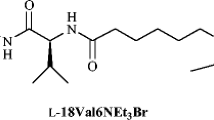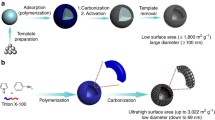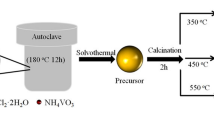Abstract
Sub-100 nm hollow carbon nanospheres with thin shells are highly desirable anode materials for energy storage applications. However, their synthesis remains a great challenge with conventional strategies. In this work, we demonstrate that hollow carbon nanospheres of unprecedentedly small sizes (down to ∼32.5 nm and with thickness of ∼3.9 nm) can be produced on a large scale by a templating process in a unique reverse micelle system. Reverse micelles enable a spatially confined Stöber process that produces uniform silica nanospheres with significantly reduced sizes compared with those from a conventional Stöber process, and a subsequent well-controlled sol–gel coating process with a resorcinol–formaldehyde resin on these silica nanospheres as a precursor of the hollow carbon nanospheres. Owing to the short diffusion length resulting from their hollow structure, as well as their small size and microporosity, these hollow carbon nanospheres show excellent capacity and cycling stability when used as anode materials for lithium/sodium-ion batteries.

Similar content being viewed by others
References
Aricò, A. S.; Bruce, P.; Scrosati, B.; Tarascon, J.-M.; van Schalkwijk, W. Nanostructured materials for advanced energy conversion and storage devices. Nat. Mater. 2005, 4, 366–377.
Simon, P.; Gogotsi, Y. Materials for electrochemical capacitors. Nat. Mater. 2008, 7, 845–854.
Stoller, M. D.; Park, S.; Zhu, Y. W.; An, J.; Ruoff, R. S. Graphene-based ultracapacitors. Nano Lett. 2008, 8, 3498–3502.
Zhang, L. L.; Zhao, X. S. Carbon-based materials as supercapacitor electrodes. Chem. Soc. Rev. 2009, 38, 2520–2531.
Zhai, Y. P.; Dou, Y. Q.; Zhao, D. Y.; Fulvio, P. F.; Mayes, R. T.; Dai, S. Carbon materials for chemical capacitive energy storage. Adv. Mater. 2011, 23, 4828–4850.
Gong, K. P.; Du, F.; Xia, Z. H.; Durstock, M.; Dai, L. M. Nitrogen-doped carbon nanotube arrays with high electrocatalytic activity for oxygen reduction. Science 2009, 323, 760–764.
Serp, P.; Corrias, M.; Kalck, P. Carbon nanotubes and nanofibers in catalysis. Appl. Catal. A: Gen. 2003, 253, 337–358.
Zhao, Y.; Nakamura, R.; Kamiya, K.; Nakanishi, S.; Hashimoto, K. Nitrogen-doped carbon nanomaterials as non-metal electrocatalysts for water oxidation. Nat. Commun. 2013, 4, 2390.
Wu, J. S.; Pisula, W.; Müllen, K. Graphenes as potential material for electronics. Chem. Rev. 2007, 107, 718–747.
Brigger, I.; Dubernet, C.; Couvreur, P. Nanoparticles in cancer therapy and diagnosis. Adv. Drug Delivery Rev. 2012, 64, 24–36.
Shi Kam, N. W.; O’Connell, M.; Wisdom, J. A.; Dai, H. Carbon nanotubes as multifunctional biological transporters and near-infrared agents for selective cancer cell destruction. Proc. Natl. Acad. Sci. USA 2005, 102, 11600–11605.
Lijima, S.; Ichihashi, T. Single-shell carbon nanotubes of 1-nm diameter. Nature 1993, 363, 603–605.
Ajayan, P. M. Nanotubes from carbon. Chem. Rev. 1999, 99, 1787–1800.
Baughman, R. H.; Zakhidov, A. A.; de Heer, W. A. Carbon nanotubes—The route toward applications. Science 2002, 297, 787–792.
Li, Z.; Zhang, J. T.; Lou, X. W. Hollow carbon nanofibers filled with MnO2 nanosheets as efficient sulfur hosts for lithium-sulfur batteries. Angew. Chem., Int. Ed. 2015, 54, 12886–12890.
Geim, A. K.; Novoselov, K. S. The rise of graphene. Nat. Mater. 2007, 6, 183–191.
Allen, M. J.; Tung, V. C.; Kaner, R. B. Honeycomb carbon: A review of graphene. Chem. Rev. 2010, 110, 132–145.
Stankovich, S.; Dikin, D. A.; Dommett, G. H. B.; Kohlhaas, K. M.; Zimney, E. J.; Stach, E. A.; Piner, R. D.; Nguyen, S. T.; Ruoff, R. S. Graphene-based composite materials. Nature 2006, 442, 282–286.
Zhu, Y. W.; Murali, S.; Cai, W. W.; Li, X. S.; Suk, J. W.; Potts, J. R.; Ruoff, R. S. Graphene and graphene oxide: Synthesis, properties, and applications. Adv. Mater. 2010, 22, 3906–3924.
Jun, S.; Joo, S. H.; Ryoo, R.; Kruk, M.; Jaroniec, M.; Liu, Z.; Ohsuna, T.; Terasaki, O. Synthesis of new, nanoporous carbon with hexagonally ordered mesostructure. J. Am. Chem. Soc. 2000, 122, 10712–10713.
Meng, Y.; Gu, D.; Zhang, F. Q.; Shi, Y. F.; Yang, H. F.; Li, Z.; Yu, C. Z.; Tu, B.; Zhao, D. Y. Ordered mesoporous polymers and homologous carbon frameworks: Amphiphilic surfactant templating and direct transformation. Angew. Chem., Int. Ed. 2005, 44, 7053–7059.
Lee, J.; Kim, J.; Hyeon, T. Recent progress in the synthesis of porous carbon materials. Adv. Mater. 2006, 18, 2073–2094.
Liu, J.; Yang, T. Y.; Wang, D.-W.; Lu, G. Q.; Zhao, D. Y.; Qiao, S. Z. A facile soft-template synthesis of mesoporous polymeric and carbonaceous nanospheres. Na. Commun. 2013, 4, 2798.
Tang, J.; Liu, J.; Li, C. L.; Li, Y. Q.; Tade, M. O.; Dai, S.; Yamauchi, Y. Synthesis of nitrogen-doped mesoporous carbon spheres with extra-large pores through assembly of diblock copolymer micelles. Angew. Chem., Int. Ed. 2015, 54, 588–593.
Liu, J.; Wickramaratne, N. P.; Qiao, S. Z.; Jaroniec, M. Molecular-based design and emerging applications of nanoporous carbon spheres. Mater. 2015, 14, 763–774.
Liu, J.; Qiao, S. Z.; Liu, H.; Chen, J.; Orpe, A.; Zhao, D. Y.; Lu, G. Q. Extension of the Stöber method to the preparation of monodisperse resorcinol-formaldehyde resin polymer and carbon spheres. Angew. Chem., Int. Ed. 2011, 50, 5947–5951.
White, R. J.; Tauer, K.; Antonietti, M.; Titirici, M. M. Functional hollow carbon nanospheres by latex templating. J. Am. Chem. Soc. 2010, 132, 17360–17363.
Tang, K.; Fu, L. J.; White, R. J.; Yu, L. H.; Titirici, M. M.; Antonietti, M.; Maier, J. Hollow carbon nanospheres with superior rate capability for sodium-based batteries. Adv. Energy Mater. 2012, 2, 873–877.
Chen, A. B.; Yu, Y. F.; Lv, H. J.; Wang, Y. Y.; Shen, S. F.; Hu, Y. Q.; Li, B.; Zhang, Y.; Zhang, J. Thin-walled, mesoporous and nitrogen-doped hollow carbon spheres using ionic liquids as precursors. J. Mater. Chem. A 2013, 1, 1045–1047.
Zheng, G. Y.; Lee, S. W.; Liang, Z.; Lee, H. W.; Yan, K.; Yao, H. B.; Wang, H. T.; Li, W. Y.; Chu, S.; Cui, Y. Interconnected hollow carbon nanospheres for stable lithium metal anodes. Nat. Nanotechnol. 2014, 9, 618–623.
Mezzavilla, S.; Baldizzone, C.; Mayrhofer, K. J. J.; Schüth, F. General method for the synthesis of hollow mesoporous carbon spheres with tunable textural properties. ACS Appl. Mater. Interfaces 2015, 7, 12914–12922.
Zang, J.; An, T. H.; Dong, Y. J.; Fang, X. L.; Zheng, M. S.; Dong, Q. F.; Zheng, N. F. Hollow-in-hollow carbon spheres with hollow foam-like cores for lithium–sulfur batteries. Nano Res. 2015, 8, 2663–2675.
Li, Z.; Zhang, J. T.; Guan, B. Y.; Wang, D.; Liu, L. M.; Lou, X. W. A sulfur host based on titanium monoxide@carbon hollow spheres for advanced lithium-sulfur batteries. Nat. Commun. 2016, 7, 13065.
Joo, J. B.; Lee, I.; Dahl, M.; Moon, G. D.; Zaera, F.; Yin, Y. D. Controllable synthesis of mesoporous TiO2 hollow shells: Toward an efficient photocatalyst. Adv. Funct. Mater. 2013, 23, 4246–4254.
Joo, J. B.; Vu, A.; Zhang, Q.; Dahl, M.; Gu, M. F.; Zaera, F.; Yin, Y. D. A sulfated ZrO2 hollow nanostructure as an acid catalyst in the dehydration of fructose to 5-hydroxymethylfurfural. ChemSusChem 2013, 6, 2001–2008.
Gao, C. B.; Lu, Z. D.; Yin, Y. D. Gram-scale synthesis of silica nanotubes with controlled aspect ratios by templating of nickel-hydrazine complex nanorods. Langmuir 2011, 27, 12201–12208.
Zhao, H. Y.; Wang, D. W.; Gao, C. B.; Liu, H. Y.; Han, L.; Yin, Y. D. Ultrafine platinum/iron oxide nanoconjugates confined in silica nanoshells for highly durable catalytic oxidation. J. Mater. Chem. A 2016, 4, 1366–1372.
Zhang, T. T.; Zhao, H. Y.; He, S. N.; Liu, K.; Liu, H. Y.; Yin, Y. D.; Gao, C. B. Unconventional route to encapsulated ultrasmall gold nanoparticles for high-temperature catalysis. ACS Nano 2014, 8, 7297–7304.
Yu, H. X.; Zhang, Q.; Joo, J. B.; Li, N.; Moon, G. D.; Tao, S. Y.; Wang, L. J.; Yin, Y. D. Porous tubular carbon nanorods with excellent electrochemical properties. J. Mater. Chem. A 2013, 1, 12198–12205.
Wang, J. S.; Shah, Z. H.; Zhang, S. F.; Lu, R. W. Silica-based nanocomposites via reverse microemulsions: Classifications, preparations, and applications. Nanoscale 2014, 6, 4418–4437.
Stöber, W.; Fink, A.; Bohn, E. Controlled growth of monodisperse silica spheres in the micron size range. J. Colloid Interface Sci. 1968, 26, 62–69.
Li, N.; Zhang, Q.; Liu, J.; Joo, J.; Lee, A.; Gan, Y.; Yin, Y. D. Sol-gel coating of inorganic nanostructures with resorcinol-formaldehyde resin. Chem. Commun. 2013, 49, 5135–5137.
Yokoi, T.; Sakamoto, Y.; Terasaki, O.; Kubota, Y.; Okubo, T.; Takashi, T. Periodic arrangement of silica nanospheres assisted by amino acids. J. Am. Chem. Soc. 2006, 128, 13664–13665.
Joo, J. B.; Zhang, Q.; Dahl, M.; Lee, I.; Goebl, J.; Zaera, F.; Yin, Y. D. Control of the nanoscale crystallinity in mesoporous TiO2 shells for enhanced photocatalytic activity. Energy Environ. Sci. 2012, 5, 6321–6327.
Kudin, K. N.; Ozbas, B.; Schniepp, H. C.; Prud’homme, R. K.; Aksay, I. A.; Car, R. Raman spectra of graphite oxide and functionalized graphene sheets. Nano Lett. 2008, 8, 36–41.
Sun, G. L.; Li, X. J.; Qu, Y. D.; Wang, X. H.; Yan, H. H.; Zhang, Y. J. Preparation and characterization of graphite nanosheets from detonation technique. Mater. Lett. 2008, 62, 703–706.
Shen, F.; Zhu, H. L.; Luo, W.; Wan, J. Y.; Zhou, L. H.; Dai, J. Q.; Zhao, B.; Han, X. G.; Fu, K.; Hu, L. B. Chemically crushed wood cellulose fiber towards high-performance sodium-ion batteries. ACS Appl. Mater. Interfaces 2015, 7, 23291–23296.
Fan, Z. Y.; Wang, B. R.; Xi, Y. X.; Xu, X.; Li, M. Y.; Li, J.; Coxon, P.; Cheng, S. D.; Gao, G. X.; Xiao, C. H. et al. A NiCo2O4 nanosheet-mesoporous carbon composite electrode for enhanced reversible lithium storage. Carbon 2016, 99, 633–641.
Fan, Z. Y.; Liang, J.; Yu, W.; Ding, S. J.; Cheng, S. D.; Yang, G.; Wang, Y. L.; Xi, Y. X.; Xi, K.; Kumar, R. V. Ultrathin NiO nanosheets anchored on a highly ordered nanostructured carbon as an enhanced anode material for lithium ion batteries. Nano Energy 2015, 16, 152–162.
Liang, J.; Yu, X. Y.; Zhou, H.; Wu, H. B.; Ding, S. J.; Lou, X. W. Bowl-like SnO2@carbon hollow particles as an advanced anode material for lithium-ion batteries. Angew. Chem., Int. Ed. 2014, 53, 12803–12807.
Acknowledgements
C. B. G. acknowledges the support from the National Natural Science Foundation of China (Nos. 21671156 and 21301138), the Tang Scholar Program from the Cyrus Tang Foundation, and the start-up fund from Xi’an Jiaotong University. X. G. H acknowledges the programs supported by State Key Laboratory of Electrical Insulation and Power Equipment (No. EIPE17306) and Young Talent Support Plan of Xi’an Jiaotong University. Y. D. Y. acknowledges the support from U.S. Department of Energy (No. DE-SC0002247).
Author information
Authors and Affiliations
Corresponding authors
Electronic Supplementary Material
Rights and permissions
About this article
Cite this article
Zhao, H., Zhang, F., Zhang, S. et al. Scalable synthesis of sub-100 nm hollow carbon nanospheres for energy storage applications. Nano Res. 11, 1822–1833 (2018). https://doi.org/10.1007/s12274-017-1800-3
Received:
Revised:
Accepted:
Published:
Issue Date:
DOI: https://doi.org/10.1007/s12274-017-1800-3




